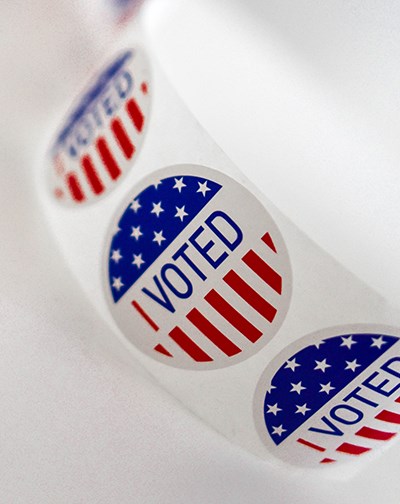
It probably gets tiring hearing every two years or so that freedom is in the balance, but, unfortunately, every two years or so, freedom is in the balance. There is no such thing as an election that doesn’t matter. November’s midterms present no exception to that rule.
If they manage to expand—or even to retain—their full control of Washington, D.C., there is no doubt that U.S. Senate Majority Leader Chuck Schumer (D-N.Y.) and Speaker of the House Nancy Pelosi (D-Calif.) will look to push a stricter gun-control bill than the one they managed in June of 2022. Introducing that measure, Sen. Chris Murphy (D-Conn.) was open about his longer-term intentions. The legislation under debate, Murphy explained, was “a breakthrough moment” that would “provide us the momentum to be able to make further changes.” What are those further changes? “I want to ban assault weapons,” Murphy confirmed at his press conference. “I support universal background checks.” If he were to find himself in a larger congressional majority, Murphy would get the chance to turn that support into action.
Thus far, bills to ban “assault weapons” and impose “universal background checks” have failed to make it through Congress. But not by much. Alarmingly, both measures passed the U.S. House of Representatives, and would likely have passed in the U.S. Senate if there were just one or two more anti-gun senators. Had the Democrats had just a few more senators in place, the filibuster would have been abolished, and both bills would have been approved by the House, approved by the Senate and signed by the president. And that would have been that. At the stroke of a pen, the federal government would have outlawed the sale of the most-popular rifles in the United States—rifles that are clearly protected by the “in common use” standard under D.C. v. Heller (2008). With the stroke of a pen, the federal government would have banned the sale or transfer of magazines that hold more than 15 rounds. The federal government would have also begun to superintend every single firearms transfer, in every state in the union. And, having done so, Sen. Murphy and other figures like him would have been sure to hold press conferences to say they were pleased with the “breakthrough moment” that provided the “momentum to make further changes.”
 Americans who do not wish to see such a “moment”—or the “momentum” it generates—must remember that history is written by the people who show up.
Americans who do not wish to see such a “moment”—or the “momentum” it generates—must remember that history is written by the people who show up.
The aim of pro-Second Amendment voters cannot solely be to take the Senate gavel away from Sen. Schumer and the House gavel away from Rep. Pelosi—although that aim is, of course, crucial—but to create large-enough margins of pro-freedom legislators in both chambers of Congress that bad legislation can be overcome, too.
As control of the U.S. Senate is likely to remain close, some have noted that because new legislation requires confirmation in both the U.S. House of Representatives and the U.S. Senate, winning control of the House while losing the Senate would be sufficient to prevent President Joe Biden’s (D) gun-control agenda. But this is incorrect. Taking back the House is, of course, enormously important, because it will stop the vast majority of Biden-backed bills in their tracks, and because it will allow at least one branch of the federal government to perform scrutiny and oversight on the executive branch. But there are certain constitutional functions—the approval of cabinet officials and the elevation of judges, for example—that bypass the House completely. These matter enormously.
For the first time in a generation, the U.S. Supreme Court has a majority that is willing to uphold the Second Amendment against elected officials who seek to undermine it. Recently, in the case of New York State Rifle & Pistol Association v. Bruen, Justice Clarence Thomas wrote for a 6-3 majority that the constitutional right to keep and bear arms requires that “authorities must issue concealed-carry licenses whenever applicants satisfy certain threshold requirements, without granting licensing officials discretion to deny licenses based on a perceived lack of need or suitability.” Or, to put it another way, in Bruen, the Court ruled that every state in the union is required to have a “shall-issue” permitting system, at a minimum, for the bearing of arms in public.
In addition, Thomas’ opinion made it clear that “when the Second Amendment’s plain text covers an individual’s conduct, the Constitution presumptively protects that conduct, and to justify a firearm regulation the government must demonstrate that the regulation is consistent with the Nation’s historical tradition of firearm regulation.” The importance of that sentence cannot be overstated, for, in essence, Thomas was instructing the lower courts that when they examine gun cases going forward, they must not put their thumbs on the scale by using “means-end tests” or “intermediate scrutiny” but must look to the historical meaning of the text.
Which is all well and good—providing that those lower courts are full of judges who care what the Constitution says and care about what the Supreme Court has ruled regarding what the Constitution says. Do they? Historically, the answer has too often been “no.” When D.C. v. Heller was decided in 2008, it was broadly assumed that it would usher in a new era for the Second Amendment. But few people anticipated that a substantial number of lower-court judges would play clever games with Heller’s meaning, and that, when they did, the still-divided Supreme Court would decline to intervene. The result was a stalemate that rendered Heller more of a theoretical victory than a practical one.
As Bruen clearly showed, the appointment of Justices Neil Gorsuch, Brett Kavanaugh and Amy Coney Barrett to the bench has rendered the Supreme Court more willing to get involved. But it would be a mistake for Americans to conclude from this that the job has now been done. Two of the justices who voted with the majority in Bruen are over 70. If they should choose to retire in the next couple of years—or if they were to retire due to failing health—then Biden would be charged with replacing them. What sort of replacement he could get would depend entirely on the makeup of the Senate. As for the recalcitrant lower court judges who have been instrumental in ensuring that Heller has been routinely ignored? Unfortunately, many of them are still there, and, thanks to the gun-control-supporting politicians’ razor-thin control of the upper chamber, those judges have been joined since January 2021 by dozens of others who think like them. If voters wish to ensure that the benches at all levels are filled with judges who respect the U.S. Bill of Rights as it is written, then they must ensure that the people who have been charged with selecting them—that is, the members of the U.S. Senate—share their desire.
This November 8, if voters elect a majority of pro-freedom members of Congress, then a lot of President Joe Biden’s (D) gun-control ambitions can be stopped.
Per the U.S. Constitution, the Senate is also solely responsible for approval of members of the president’s cabinet. If the American system of government were working as designed, it would not especially matter who sat in that Cabinet: Under Article I, it is Congress, not the executive branch, that makes the laws. But the American system of government is not always working as designed, and, in consequence, the men and women who head up the federal government’s various agencies have an extraordinary amount of power to determine what the law means, and where and when and against whom it will be enforced.
A Senate that is full of pro-Second Amendment senators is a Senate that can ensure that President Biden cannot appoint unacceptable candidates to the federal bureaucracy. There is no good reason that the United States should have a surgeon general, Vivek Murthy, who is hostile toward one of the provisions within the U.S. Bill of Rights, or an ATF Director, Steve Dettelbach, who seeks to prohibit AR-type rifles or an HHS Director, Xavier Becerra, who believes that his job is to advocate for the undermining of the right to keep and bear arms in the name of public health. A core aim of pro-Second Amendment voters should be to ensure that nobody else like those ideologues makes it past the approval process.
And then there are the states—where most of the meaningful legislative action in America takes place. Of the 50 states in the union, 45 hold their gubernatorial and legislative elections in even years such as this one. In our nationalized political culture, it can be tempting to focus all of our attentions on Washington, D.C. But that, of course, would be a great mistake, because, at the state and local level, the incentives to elect the right people are arguably even greater than they are federally. Yes, there remains the ever-present threat of lawmakers who hope to impose further restrictions on the purchase, transfer and carrying of arms. But there is also a far-higher chance that the correct set of state lawmakers will expand the right to keep and bear arms. There is no excuse for us to pass up that chance.
If one were to take America’s gun-control advocates at face value, one would have no choice but to conclude that the remarkable liberalization of America’s gun laws that we have seen over the last three decades was the work of the courts. But this simply isn’t true. Indeed, it has been the state legislatures that have driven our recent Second Amendment renaissance, and, far from mindlessly obeying a cabal of interventionist judges, those state legislatures have been responding directly to the will of the people. Bit by bit, year by year, a majority of the states have chipped away at America’s useless, draconian or unconstitutional laws—to the point at which, by the time the Bruen decision came down, 43 states had either adopted “shall-issue” concealed-carry regimes or had removed their requirement to obtain a permit to lawfully carry a firearm for personal protection. Elsewhere, states have nixed registries, removed licensing requirements for the purchase of handguns, abandoned one-gun-per-month rules, legalized open carry and expanded the places to which law-abiding citizens can bring firearms for their defense.
 This did not happen by accident. It happened because, year in, year out, American citizens demanded it. How? By going out to vote for their freedom with this association helping them; by making sure that the people for whom they were voting were in alignment with their values; by making clear that, if those people did not act in line with their values, they would be removed; and then, long after the elections were over, by reminding those whom they had chosen that they expected to see progress when the state government was in session. In most states, the result of these efforts has been 30 years of improvements to the gun laws of the United States.
This did not happen by accident. It happened because, year in, year out, American citizens demanded it. How? By going out to vote for their freedom with this association helping them; by making sure that the people for whom they were voting were in alignment with their values; by making clear that, if those people did not act in line with their values, they would be removed; and then, long after the elections were over, by reminding those whom they had chosen that they expected to see progress when the state government was in session. In most states, the result of these efforts has been 30 years of improvements to the gun laws of the United States.
But there is a cautionary part of this tale: namely, that the people who work the hardest and the most consistently tend to prevail, and that there is nothing written in the stars that guarantees that the pro-Second Amendment side will work harder and more consistently than its opponents. Since the early 1990s, we have achieved a great deal, but, if we forget how we did it, or fall into complacency, we could lose it all just as easily.
So let’s not do that. Instead, let’s count our blessings where we have blessings (most of the states, the Supreme Court), acknowledge our problems where we have problems (President Biden, many in Congress), and resolve to press our advantage where we have advantages. We’ve done it before, and we can do it again this November—by doing our homework, by grasping the stakes and, most importantly of all, by showing up to vote en masse.


































